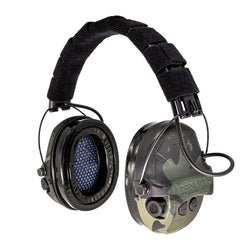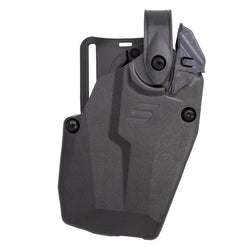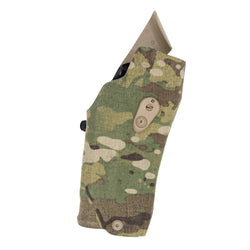Keeping your gun running is the key to saving lives, winning matches, and looking oh-so-sweet on the ‘Gram. We keep our gun-running by learning how to reload properly. Today, we are going down Reload Road with the AR-15 and a belt-mounted Safariland 774 open-top pouch.

This basic thermomolded polymer pouch stores one AR-15 magazine via passive retention. The retention can be adjusted slightly to accommodate the varying sizes of AR magazines.
The Safariland 774 can be swapped for right- or left-handed use. It can also be converted to work on a chest rig or plate carrier. Today, it’s on a belt. The reloads from a chest rig or plate carrier can vary, and today, we are just focusing on belt-mounted reloads.
Before we can execute a reload, we have to be set up for success.
The AR Reload: Setup for Success
There is only one hard and fast rule for setting up a belt-mounted reload: The brass needs to face the grass. This means the open top of your ammo needs to be downward inside the pouch, and the bottom of the magazine should be facing upward. That’s the only hard and fast rule.

Everything else is up to the end user. Typically, the Safariland 774 will be positioned on the shooter’s nondominant side. The majority of the reload will be done with a nondominant hand. However, we’ve all seen varying setups and shooters who have a reason for alternative positioning.
If we break the direction of the body down to clock positions, the 774 will be positioned anywhere from the 7 to 11 o’clock position for right-handed shooters. For wrong-handers, it will be positioned anywhere from 1 to 5 o’clock. That’s a lot of different positions, and plenty of shooters may take advantage of multiple positions with multiple magazine pouches.

What’s important is doing some trial and error. Never position a magazine in a position you can’t easily reach. I have shoulder problems, so I stick to the 9 to 11 o’clock positions, with 9 and 10 being my preference. At the 11 o’clock position, it feels like I can’t bend over or move as easily, even though I can reload very quickly from this position.
Try a variety of positions and find what works for you. Factor in magazine access, range of movement, and even comfort if you’re going to be carrying the magazine and belt for long periods.
The Magazine In the 774
The different positions on your belt will coordinate with how we position the magazine in the 774. We can position the magazine with the projectiles facing forward or the projectiles facing rearward. Depending on the position, you may choose one over the other. This affects how you grip the magazine.

If you’re carrying three magazines, you may decide to use two facing forward and one facing rear. If that works for you, great. I’m too much of a caveman, and under pressure, I want one grip to rule them all when it comes to reloads.
The Claw
If your magazine pouch is placed on or forward of the 3 o’clock position, you probably want to position the projectile facing forward. It’s not a requirement, but it’s a best practice. If the projectiles face forward, you’re using the claw grip.

In this case, when I draw from the 774, my palm will land at the bottom of the magazine. My pointer finger will engage the front of the magazine, and the thumb and middle finger will fall on opposite sides of the magazine.
Apply pressure with all three fingers and draw the magazine. As your hand travels to the magazine well, your wrist will rotate the magazine upward to meet the magwell.
The Beer Can Grip
If your magazine pouch is placed on or aft of the 3 o’clock position, you will position the projectiles facing rearward. Personally, I love a mag pouch at the 3 o’clock position, and I can use the beer can grip. The beer can grip is super simple.

As you retrieve the magazine, your thumb and pointer finger will face downward and grip the front and back of the magazine. You’ll pull the magazine upward and free from the 774 mag pouch. Rotate your wrist and the projectile to face the sky as your hand moves to the magwell.
Reload Types
We have two types of reloads: the speed reload and the tactical reload. Each reload has a different use case.
Speed Reload
Speed reloads are often employed in action shooting sports and when you run dry in the middle of a gunfight. For tactical uses, if you have to speed reload, it’s an “Oh crap” moment. In competition, it’s commonly the default because time matters more than ammo retention.

For a speed reload, you hit the magazine release and let it fall from your gun, then grab your magazine from your 774 pouch and drive it to the gun. If your gun is empty, you’ll need to hit the bolt release to return to a ready-fire position.
Tactical Reload
A tactical reload is a little slower and used to retain the magazine and ammo still in the gun. Tactical reloads are conducted whenever possible to ensure your weapon remains topped off and ready to rock and roll. The tactical reload requires you to retain the magazine that’s in the gun and store it on your person or in a dump pouch.
When you commit a tactical reload, you grab your spare magazine and bring it to your gun. You position your loading hand to retrieve the partially empty magazine. If you’re using the beer can method, you stack the magazines in your hand.

The fresh magazine should be positioned higher than the partially empty magazine. Hit the magazine release button, remove the partially empty magazine, and insert the fresh magazine. Your non-dominant hand will bring the partially spent magazine to wherever you plan to retain it.
If you use the claw grip, the best way to reload is to use the L technique. As you bring the fresh magazine upward, you’ll overextend your wrist forward and bring your palm to the bottom of the magazine in the gun. Grip the magazine with your finger and hit the magazine release button.

Maintain control of the partially spent magazine as you rotate your wrist back slightly and insert the fresh magazine into the gun. Stow the partial magazine, and you’re done.
Running the Reload
Now we know all about getting the magazine into the gun, but what about all the other stuff you’re supposed to do while reloading? You may have to move the rifle inward and tuck it under your arm for more stability. This depends on the weight of your rifle and your personal strength. If your rifle isn’t too heavy, you can keep it in a firing position as you reload.

If you can’t hold the gun up in the firing position, break it down under the arm, but keep it close and within your line of sight and towards a potential threat. Your eyes should focus on the reload. If your weapon is pointed at the danger area, it’s an easy transition from focusing on the reload to getting back on the threat.

Move quickly. Time spent reloading could be time spent maneuvering, shooting, or communicating. It’s a simple task and one you should train to be proficient at. Reloading the AR series is straightforward, thanks to its highly ergonomic design. It’s not tough to get fast, so practice, get fast, and get good.









